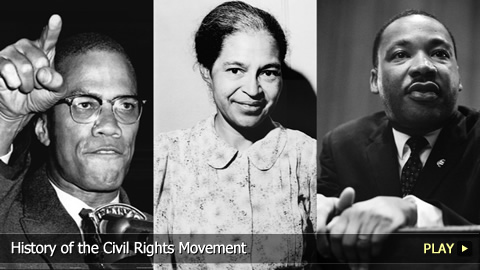History of the Civil Rights Movement

The Legal Right to Vote
As of 1870, all eligible male citizens were able to vote. However, blacks were discouraged to by violence and eventually legal stipulations. Also unable to serve on juries, African Americans were consequently left to be unfairly tried by a white legal structure.
Disenfranchisement
This disenfranchisement was encouraged because the majority of former Confederate states’ populations were comprised of African Americans, and whites feared they would seize control. As a result, voter turnout for blacks and poor whites between 1890 and 1908 dropped drastically.
"Separate But Equal"
In 1896, the Supreme Court ruled to maintain racial segregation in private businesses, in a case called Plessy v. Ferguson. Soon broadened to include schools, many southern states applied this “separate but equal” mentality to all aspects of life. However, this led to the application of Jim Crow laws, which resulted in blacks being treated as second-class citizens. Segregated schools, public transit, restrooms, water fountains and more continued well into the 1900s.
Founding of the NAACP
In 1909, a group of prominent black and white campaigners created the National Association for the Advancement of Colored People or NAACP. Their goal was to increase racial equality and challenge issues like the Jim Crow laws. Unfortunately, it was between 1910 and 1930 that white supremacist group the Ku Klux Klan saw its biggest expansion amid increased racial friction.
Integrating the School System
Following the First World War, the NAACP was devoted to ending lynching by white vigilantes. By mid-century, the group became instrumental in the Brown v. the Board of Education of Topeka court case. This class-action suit filed in 1951 asked that segregation in schools be struck down. Taken to the Supreme Court, the case resulted in the first integrated school in the United States to open in the fall of 1955.
Montgomery Bus Boycott
Encouraged by the decision, the Civil Rights Movement began to hold high-profile boycotts, marches, sit-ins and other peaceful protests. These included the Montgomery Bus Boycott of 1955 in support of Rosa Parks.
The Little Rock Nine
A watershed moment came in 1957 when a high school in Arkansas admitted a group of African American students, nicknamed the Little Rock Nine. Protested by fellow students, the governor, and even the state’s National Guard, President Dwight Eisenhower eventually intervened to ensure the students’ safe passage. By 1962, Universities also began integrating, though black students were still met with protests and violence.
Civil Rights Act of 1964
The Southern Freedom Movement continued into the ‘60s, with support from newly-elected President John F. Kennedy and his brother: Attorney General, Robert Kennedy. The violence of the Birmingham, Alabama campaign influenced the President to fully endorse the movement. On June 19th, 1963, he proposed a Civil Rights Bill to Congress, which was approved in 1964 after his death with support from President Lyndon Johnson. The bill struck down existing legislation that allowed for discrimination, and its approval was largely influenced by Martin Luther King Jr. and the March on Washington of August 1963. Capturing the attention of the media and the population, this event attracted hundreds of thousands of people in support of civil rights.
Voting Rights Act of 1965 and Watts Riots
Following that, the Voting Rights Act of 1965 ended the prejudiced voting system. Instantly effective, blacks began voting and running for public office. However, just days later on August 11th, a violent six-day riot in the Los Angeles neighborhood of Watts resulted in 34 deaths. This was indicative of a period of racially-motivated violence that occurred in the mid-to-late 1960s.
Rise of Black Power
This era also saw the rise of Black Power, led in large part by Stokely Carmichael, in opposition to extremists like the Ku Klux Klan. This ideology was exemplified by the Black Panther Party, which followed the principles set forth by Malcolm X. Rising to prominence in the 1950s, his radical ideas advocated militancy for blacks. He remained an influential and controversial human rights activist until his assassination in 1965.
The First African American President
The murders of civil rights leaders continued when Martin Luther King Jr. was killed in April 1968, and Robert Kennedy two months later. Despite racial tensions continuing into the 1990s, progress has been measurable. The election of President Barack Obama in 2008 is seen by many to be a culmination of centuries of work in favor of racial equality.


 0
0
 0
0
 flagged
flagged